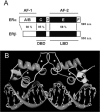Estrogen signaling multiple pathways to impact gene transcription
- PMID: 18369406
- PMCID: PMC2269003
- DOI: 10.2174/138920206779315737
Estrogen signaling multiple pathways to impact gene transcription
Abstract
Steroid hormones exert profound effects on cell growth, development, differentiation, and homeostasis. Their effects are mediated through specific intracellular steroid receptors that act via multiple mechanisms. Among others, the action mechanism starting upon 17beta-estradiol (E2) binds to its receptors (ER) is considered a paradigmatic example of how steroid hormones function. Ligand-activated ER dimerizes and translocates in the nucleus where it recognizes specific hormone response elements located in or near promoter DNA regions of target genes. Behind the classical genomic mechanism shared with other steroid hormones, E2 also modulates gene expression by a second indirect mechanism that involves the interaction of ER with other transcription factors which, in turn, bind their cognate DNA elements. In this case, ER modulates the activities of transcription factors such as the activator protein (AP)-1, nuclear factor-kappaB (NF-kappaB) and stimulating protein-1 (Sp-1), by stabilizing DNA-protein complexes and/or recruiting co-activators. In addition, E2 binding to ER may also exert rapid actions that start with the activation of a variety of signal transduction pathways (e.g. ERK/MAPK, p38/MAPK, PI3K/AKT, PLC/PKC). The debate about the contribution of different ER-mediated signaling pathways to coordinate the expression of specific sets of genes is still open. This review will focus on the recent knowledge about the mechanism by which ERs regulate the expression of target genes and the emerging field of integration of membrane and nuclear receptor signaling, giving examples of the ways by which the genomic and non-genomic actions of ERs on target genes converge.
Keywords: Estrogen; estrogen receptors; gene transcription; genomic and non-genomic action mechanism.
Figures


Similar articles
-
Role of co-activators and co-repressors in the mechanism of steroid/thyroid receptor action.Recent Prog Horm Res. 1997;52:141-64; discussion 164-5. Recent Prog Horm Res. 1997. PMID: 9238851 Review.
-
Mechanisms of estrogen receptor signaling: convergence of genomic and nongenomic actions on target genes.Mol Endocrinol. 2005 Apr;19(4):833-42. doi: 10.1210/me.2004-0486. Epub 2005 Feb 3. Mol Endocrinol. 2005. PMID: 15695368 Review.
-
Characterization of a membrane-associated estrogen receptor in breast cancer cells and its contribution to hormone therapy resistance using a novel selective ligand.J Steroid Biochem Mol Biol. 2020 Jul;201:105671. doi: 10.1016/j.jsbmb.2020.105671. Epub 2020 Apr 11. J Steroid Biochem Mol Biol. 2020. PMID: 32289430
-
Novel actions of estrogen to promote proliferation: integration of cytoplasmic and nuclear pathways.Steroids. 2009 Jul;74(7):622-7. doi: 10.1016/j.steroids.2008.10.014. Epub 2008 Nov 5. Steroids. 2009. PMID: 18996136 Free PMC article. Review.
-
Non-classical genomic estrogen receptor (ER)/specificity protein and ER/activating protein-1 signaling pathways.J Mol Endocrinol. 2008 Nov;41(5):263-75. doi: 10.1677/JME-08-0103. Epub 2008 Sep 4. J Mol Endocrinol. 2008. PMID: 18772268 Free PMC article. Review.
Cited by
-
Co-transcriptional R-loops are the main cause of estrogen-induced DNA damage.Elife. 2016 Aug 23;5:e17548. doi: 10.7554/eLife.17548. Elife. 2016. PMID: 27552054 Free PMC article.
-
Erxian decoction ameliorates myocardial tissue damage through activating PI3K/AKT signaling pathway in ovariectomized rats.Ann Med. 2024 Dec;56(1):2411013. doi: 10.1080/07853890.2024.2411013. Epub 2024 Oct 9. Ann Med. 2024. PMID: 39382555 Free PMC article.
-
Decoding breast cancer tissue-stroma interactions using species-specific sequencing.Breast Cancer Res. 2015 Aug 13;17(1):109. doi: 10.1186/s13058-015-0616-x. Breast Cancer Res. 2015. PMID: 26265142 Free PMC article.
-
Intrinsically disordered proteins play diverse roles in cell signaling.Cell Commun Signal. 2022 Feb 17;20(1):20. doi: 10.1186/s12964-022-00821-7. Cell Commun Signal. 2022. PMID: 35177069 Free PMC article. Review.
-
Cytotoxicity Of Chalcone Of Eugenia aquea Burm F. Leaves Against T47D Breast Cancer Cell Lines And Its Prediction As An Estrogen Receptor Antagonist Based On Pharmacophore-Molecular Dynamics Simulation.Adv Appl Bioinform Chem. 2019 Nov 6;12:33-43. doi: 10.2147/AABC.S217205. eCollection 2019. Adv Appl Bioinform Chem. 2019. PMID: 31807030 Free PMC article.
References
-
- Gruber CJ, Tschugguel W, Schneeberger C, Huber JC. Production and actions of estrogens. New Engl J Med. 2002;346:340–352. - PubMed
-
- Pearce ST, Jordan VC. The biological role of estrogen receptors α and β in cancer. Crit Rev Oncol Hematol. 2004;50:3–22. - PubMed
-
- Hall JM, Couse JF, Korach KS. The multifaceted mechanisms of estradiol and estrogen receptor signaling. J Biol Chem. 2001;276:36869–36872. - PubMed
-
- Nilsson S, Makela S, Treuter E, Tujague M, Thomsen J, Andersson G, Enmark E, Pettersson K, Warner M, Gustafsson JÅ. Mechanisms of estrogen action. Physiol Rev. 2001;81:1535–1565. - PubMed
LinkOut - more resources
Full Text Sources
Other Literature Sources
Research Materials
Miscellaneous
